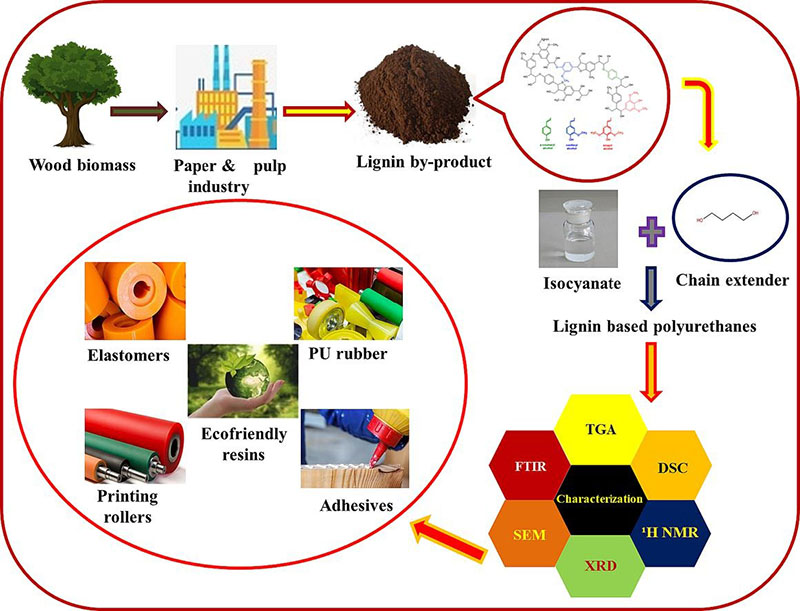Lignin Polyurethanes: Byproduct to Solution

Lignin, a significant byproduct of the pulp and paper industry, accounts for approximately 75 million tons of waste annually. This vast quantity of waste presents both a challenge and an opportunity.
Most of this lignin is traditionally burned for energy recovery, but this practice underutilizes its potential. Given the urgent need to reduce reliance on fossil fuels and mitigate environmental impacts, exploring alternative uses is critical. One promising avenue is the synthesis of polyurethanes (PU) from lignin, which can significantly contribute to developing sustainable materials. This study focuses on recent advances and prospects in synthesizing lignin-based polyurethanes (LPUs) and their applications across various industries.
You can also read: Bio-based Solvents for Polyimide Synthesis in Space Applications, Silent Polyurethane Tires for Electric Vehicles, Embracing Sustainability With Bio-based Flame Retardants
Lignin Synthesis Techniques
Recent advancements in synthesizing LPUs, a natural and renewable biomass source, have shown significant potential in replacing petroleum-based polyols. This biobased source, composed of phenylpropanoid units with abundant hydroxyl, phenol, and carbonyl groups, allows for chemical modification to enhance its properties. Techniques like alkali treatment, oxidation, prepolymer methods, haloalkane modification, and alkane depolymerization were explored. These methods have enabled the integration of lignin with petroleum-based polymers through step-growth polymerization or blending, resulting in lignin-based polyurethane (LPU) materials used in various applications, including elastomers, films, coatings, foams, and adhesives.
Environmental Benefits of Lignin

Lignin, as a byproduct of agricultural waste and wood processing, is abundant and sustainable. Its use in PU production not only conserves oil reserves but also introduces enhanced properties such as antibacterial, antioxidant, flame retardant, UV-blocking, and hydrophobic characteristics. Courtesy European Polymer Journal, Copyright (2024).
The shift to lignin-based polyurethanes supports a greener future by reducing reliance on fossil fuels and mitigating environmental impact. Lignin is abundant and sustainable as a byproduct of agricultural waste and wood processing. Its use in PU production conserves oil reserves and introduces enhanced properties such as antibacterial, antioxidant, flame retardant, UV-blocking, and hydrophobic characteristics. These features contribute to developing eco-friendly and high-performance materials, promoting sustainable development and addressing environmental concerns associated with fossil fuel depletion.
Industrial Applications
Lignin-based polyurethanes have found applications across various industries due to their versatile properties. Industries like construction, automotive, packaging, textiles, footwear, and more, employ LPUs for their mechanical strength, durability, and functional enhancements. The material’s biocompatibility makes it suitable for biomedical applications, while its structural advantages leverage shape-memory materials, self-healing materials, and gel products. The broad applicability of LPUs underscores their potential to revolutionize multiple sectors with eco-conscious solutions.
Future Prospects
The future of lignin-derived polyurethanes (LPUs) looks promising with ongoing research focused on optimizing synthesis methods and expanding applications. As extraction and modification techniques improve, the production of high-value LPUs is expected to increase. Furthermore, the integration of lignin into various industrial processes aligns with the global shift towards sustainable and renewable resources. Consequently, continued innovation in this field will likely lead to new materials with superior properties, driving the adoption of lignin-based polyurethanes in more applications and contributing to the development of environmentally friendly industries.
To read more: Lignin derived polyurethanes: Current advances and future prospects in synthesis and applications
